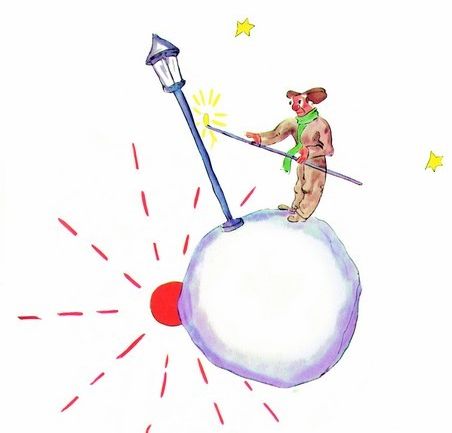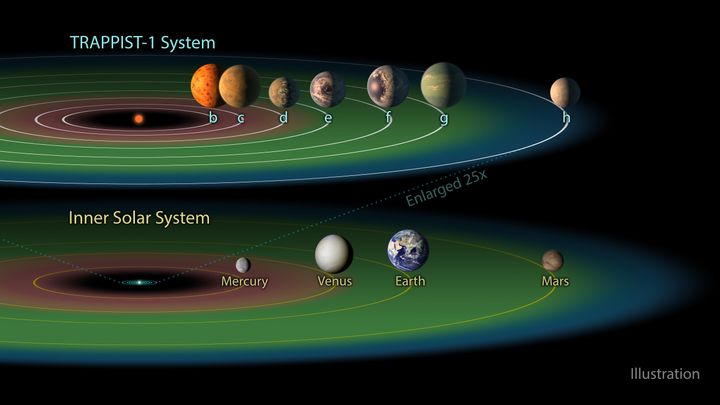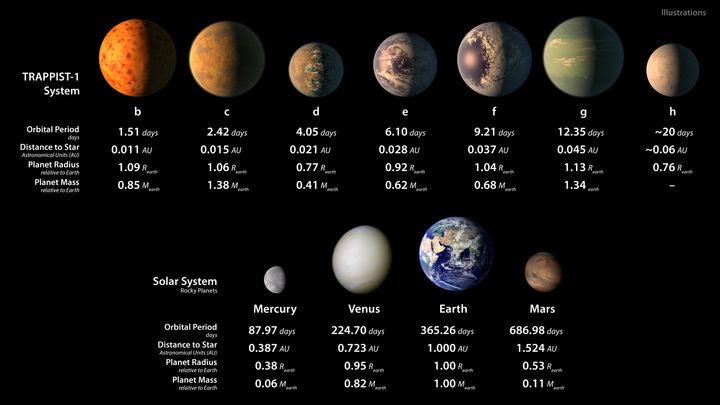The Little Prince would be very bored. Think about it: for planet f of Trappist-1, one local year (an entire revolution around the host star) lasts less than ten days! And in the meantime the planet rotates locked with the star, like the Moon—Sun system. Nothing changes on the hemisphere facing the star, you are always looking at the same reddish big disk forever, no rise, no sunset, only a long, eternal day.
The Little Prince immensely loved the sunset, at the point to envy the planet of the lamplighter, where the day lasted 1 minute, “because it was blest every day with 1440 sunsets!” (Chapter 14 of The Little Prince”)

Figure 1. The lamplighter said “Once every minute I have to light my lamp and put it out!" "That is very funny! A day lasts only one minute, here where you live!" "It is not funny at all!" said the lamplighter. "While we have been talking together a month has gone by."
Yes, I generally remember the Little Prince, when I reason about the way we imagine the planetary system Trappist-1, told to be possible location of extraterrestrial life, and in some ways to be similar to our own solar system... The narration of NASA/JPL is mainly focused on a few facts: 1) the star hosts seven terrestrial planets; 2) three planets (e, f, g) should be enclosed in the “habitable zone” (Figure 2); 3) their masses are very similar to the Earth mass (Figure 4). The planets dimensions (and mass) are indeed different from those explored by the Little Prince, which, if I remember correctly, are all very small.

Figure 2. The “habitable zone” of Trappist-1, where, in principle, water may be at the liquid stage, includes planets e, f and g, while the Solar System zone includes Venus, Earth and Mars.
An appealing comparison is displayed in the dimensions picture on the JPL/Spitzer pages, showing that Trappist-1 is much more similar to the system of Jupiter’s plus its Medicean satellites than to the solar system. In fact, the whole planets of Trappist-1 would be well contained inside Mercury’s orbit.

Figure 3. On the top, the Galileian planets of Jupiter are shown on their orbit, on the same scale as the Trappist-1 system in the center. At the bottom, the image shows that the entire Trappist-1 system would be contained will within Mercury’s orbit.
The combination of the mass of Trappist-1 host star (about 80 times Jupiter’s) with the Earth-like planets mass (much more massive than Jupiter’s moons) is such that the total dimension of the orbits are only about a factor four smaller for Jupiter, while the revolution periods are very similar, about 1.5 to 12 days for the Medicean satellites and 1.7 to 20 days for Trappist-1 planets (Figure 4). Notice that Mercury’s year is as long as 88 days.

Figure 4. Artist concepts of the seven planets of TRAPPIST-1 with their orbital periods, distances from their star, radii and masses as compared to those of Earth. The same numbers are displayed for the solar system planet Mercury, Venus, Earth and Mars.
In the colorful view of my friend Luciano Burderi, we may “realistically” imagine Trappist-1 by taking Jupiter and its moons and putting them in the middle of nowhere. If we look at this extrasolar planetary system in this way, it is really difficult for us to believe that it is akin to our solar system.
Let us go back to the difference between us and “them” mentioned at the beginning. The small distances of the planets from the central star imply that tidal forces have acted to synchronize rotation and revolution, so that these earths always show the same side to the star (like the Moon with the Earth). This is a terrible complication for the birth and survival of life... The illuminated side may be too hot, so that water evaporates, the back side may be too cool. The best bet is that life ”might” be possible in the dusk zones. And the host star will be so long lived (about 3000 billion years!) that we might bet that, even if there is no life “now”, it has a chance to be born, soon or later (Avi Loeb and colleagues show that, unless habitability around low mass stars is suppressed, life is 1,000 times more likely to exist 10 trillion years from now around stars that weigh one-tenth the mass of the Sun).
Nevertheless, there is still something to dream of, for people who love stars: the intelligent beings of planet f in Trappist-1, at some point of their history would reach the back, never-ending dark, side of the planet, and they will have the chance to become the greatest astronomers of the Galaxy: they will see the whole stellar sky rotate by 360 degrees in ten days. The Milky Way, the disk of our Galaxy, with all its trail of stars, clusters and dark clouds, will rise, cross 36 degrees of the sky each (terrestrial) day, and then set down to reappear a few days later. I am sure that the Little Prince would like this exalting view, and forgive the lack of sunsets.
